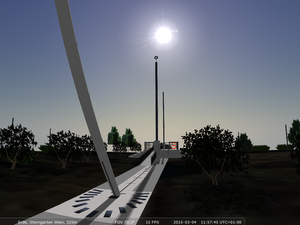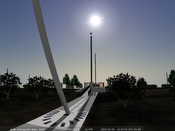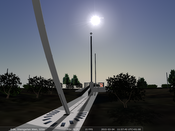Information
- Publication Type: Student Project
- Workgroup(s)/Project(s):
- Date: 2015
- Date (Start): 13. October 2014
- Date (End): 12. March 2015
- Matrikelnummer: 0927289
- First Supervisor:
- Keywords: stellarium
Abstract
Scenery3d is a plugin for the open-source Stellarium planetarium application allowing users to freely observe and analyze 3D architectural structures under a realistic astronomical simulation, including realistic lighting and shadowing. During this project, we ported the pre-existing codebase (from 2012) to the current version of Stellarium, which required several structural changes like a change from Qt 4 to Qt 5 and a fully shader-based renderer. We also focused on improving the rendering performance and quality, and increased usability and code maintainability. Because a big feature of Stellarium is the use of non-linear projections which require more sophisticated rendering methods, several steps have been taken to increase the subjective performance of these methods to increase interactivity. For increasing the shadow quality, percentage-closer soft shadows were implemented. Finally, the plugin was made compatible with OpenGL ES 2.0, for use on embedded platforms or desktops without a suitable OpenGL driver.Links:
Stellarium: http://stellarium.org
Launchpad (Code): https://code.launchpad.net/~stellarium-scenery3d/stellarium/scenery3d_Qt5
Direct link to user documentation: https://bazaar.launchpad.net/~stellarium-scenery3d/stellarium/scenery3d_Qt5/download/head:/pluginsscenery3ddocs-20111013124518-6rr9sbb5zt1w2ylg-2/Scenery3d.pdf
Additional Files and Images
Weblinks
No further information available.BibTeX
@studentproject{SCHAUKOWITSCH-2015-STELL,
title = "Stellarium 3D Integration",
author = "Florian Schaukowitsch",
year = "2015",
abstract = "Scenery3d is a plugin for the open-source Stellarium
planetarium application allowing users to freely observe and
analyze 3D architectural structures under a realistic
astronomical simulation, including realistic lighting and
shadowing. During this project, we ported the pre-existing
codebase (from 2012) to the current version of Stellarium,
which required several structural changes like a change from
Qt 4 to Qt 5 and a fully shader-based renderer. We also
focused on improving the rendering performance and quality,
and increased usability and code maintainability. Because a
big feature of Stellarium is the use of non-linear
projections which require more sophisticated rendering
methods, several steps have been taken to increase the
subjective performance of these methods to increase
interactivity. For increasing the shadow quality,
percentage-closer soft shadows were implemented. Finally,
the plugin was made compatible with OpenGL ES 2.0, for use
on embedded platforms or desktops without a suitable OpenGL
driver. Links: Stellarium: http://stellarium.org
Launchpad (Code):
https://code.launchpad.net/~stellarium-scenery3d/stellarium/scenery3d_Qt5
Direct link to user documentation:
https://bazaar.launchpad.net/~stellarium-scenery3d/stellarium/scenery3d_Qt5/download/head:/pluginsscenery3ddocs-20111013124518-6rr9sbb5zt1w2ylg-2/Scenery3d.pdf
",
keywords = "stellarium",
URL = "https://www.cg.tuwien.ac.at/research/publications/2015/SCHAUKOWITSCH-2015-STELL/",
}



